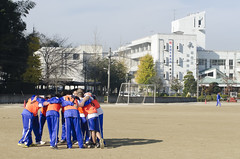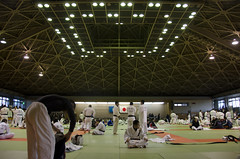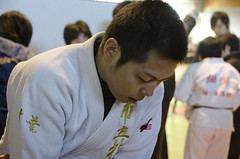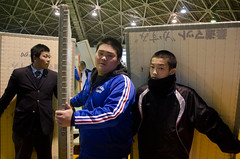We were just finishing up a conversation on rhetoric in the public sphere. I had introduced the topic with a couple of articles that I pulled off the internet about "Reading Level" and "Reading Difficulty" as a way to introduce variable English forms for Specific Purposes.
And while the topic of EfSP was interesting to them, they naturally gravitated to comparable experiences they've had with the immediately accessible rhetoric of the public sphere, which meant contrasting the speaking styles of political candidates.
"American speakers," they were adamant, "sound much more knowledgeable, much more professional than Japanese speakers."
It was decided, then, that all speakers throughout all of Japan could learn a thing or two from American speech makers.
"But, Kevin-sensei," one of them inquired, "do you think that she wrote this speech herself? That what she is saying is truly what she believes?" I couldn't help but smirk to myself. There's nothing quite like a lesson plan coming together. "Or that she is saying it this way because she knows it sounds more beautiful? Or that this other speech is written in a more simple style because the people she's trying to speak to understand it better?"
The smirk was spreading into a smile. My arms were smugly crossed over my chest and my legs were halfway to being propped up on the desk.
But he didn't stop there.
After a beat, he shook his head and continued. "I know it sounds nicer; American speeches, that is. But American rhetoric is all just for show. I prefer Japanese speeches because they're more clear: they're more real."
Wait. What?
As Massimiliano Tomasi writes
1Tomasi, Massimiliano. "Studies of Western Rhetoric in Modern Japan: The Years between Shimamura Hōgetsu's Shin bijigaku (1902) and the End of the Taishō Era." Japan Review 16 (2004): 161-190. Print.
1, it would be disingenuous to suggest that Japan had no rhetorical history prior to the Meiji Revolution. One would be heedlessly ignoring centuries of poetic and homiletic tradition in favor of a white-washed narrative that, while more simple, would simply be wrong.But no matter how fascinated Buddhist monks seemed in "the power of the spoken word," even Tomasi cannot ignore the great impact that the Western "science" of rhetoric has had on the development of a Japanese rhetorical tradition. Or, rather, the dramatic stagnation.
Tomasi, himself, begins his article by noting that he had begun to do research on the topic because he was tired of scholars assuming that Japanese rhetoric originated during the Meiji Restoration (明治維新, めいじいしん: 1868-19812), arguing that these academics ignore the vast collection of works written during the Heian (平安: 794-1185) and Kamakura (鎌倉: 1185-1333) periods. But he also notes that much of what passed for rhetorical tradition was more-or-less poetics, being that a vast preponderance of public speaking was reserved for preachers and teachers, done in a sort of "one-way form of communication that often placed the speaker in a position of superiority" (162). For pre-restoration audiences, the content was compelling not because of the veracity or logicality of the argument, but strictly because of the credentials and expertise of the one who speaks.
Since the primary function of rhetoric is to appeal to the audience's trust with logic and feeling--the building of one's own oratorical credentials--the strict adherence to the teacher-apprentice dynamic renders much of rhetoric as a field of study pointless. After all, one listens to a doctor because of the certificates on his wall which guarantees (supposes) experience and wisdom, not because of the smoothness of his bedside manner. Or at least most of us do.
It was not until the Freedom and Popular Rights Movement (自由民権運動, じゆうみんけんうんどう) that "the authority of the speaker was now no longer taken for granted" (163). "The orator had to win the confidence of his audience and persuade them of the veracity of his arguments" (163). As a "framework around which ideas and information could be exchanged," rhetoric, as a field of study, was primed to make its grand entrance into the realm of Japanese discourse (163). But things are never so easy.
In the west, rhetoric was the champion of progress and democracy, allowing every man the right to frame and credential his own argument, separate from himself, allowing the arguments posited to stand upon their own merit. Despite this opportunity, discussions regarding oral communication squarely placed the study of "rhetoric," or 言文一致 (げんぶにっち, or "unification"), on the outside of democratization. In Japan, rhetoric was seen as focusing on ornamentation, eschewing effectiveness and content in an attempt to sound highfalutin.
The preponderance of academic minds believed that 文壇 (ぶんだん--"bundan") was the true tool of the common man. 文壇 was deemed the "language of the people," focusing on Realism and Naturalism in writing, setting up rhetoric as antithetical to this populist movement. A call was made by the highest thinkers for a "literary style devoid of rhetorical elements," arguing against "any form of elaborate expression that might compromise the truthfulness of facts and events" (164).
It is because proponents of rhetoric bought into this false dichotomy that such thinking still persists today. Many of the people I've talked to about rhetoric
2Anecdote.
2 still believe that rhetoric represents the antithesis of faithful and concise writing, suggesting that all rhetoric is akin to affectation.It wasn't until late into the Meiji Era that "vernacular choice" was included within the structures of rhetoric. 五十嵐力 (Igarashi Chikara) dropped the hammer in his 1909 work, 新文相講話 (しんぶんしょうこうわ), noting that (as Tomasi summarizes), "the difference between the old [vernacular] and new [rhetorical] styles did not lie in the presence or absence of rhetorical devices, but in the very nature of those devices" (172). In fact, "writing without rhetorical devices was itself an extreme rhetorical artifice" (172). To choose to write in plain Japanese without ornamental embellishment was, in deed, a rhetorical decision: between the "Rhetoric of Romanticism" and the "Rhetoric of Realism" (175).
But by the time Igarashi wrote his treatise, interest in rhetoric as a field of study had waned
3As I'm sure yours has.
3. 言文一致 had firmly rooted itself as the predominant style of public discourse and writing, a style that unflaggingly remains popular today.This uncritical approach to rhetoric probably does not seem out of place to anyone who has spent any time in a Japanese community. Especially because the more time one spends in Japan the clearer it becomes that the one thing that Japanese people love more than anything else seems to be making speeches
4It's quite possible, however, that Japanese people love making non-Japanese speaking people give speeches in Japanese, but that's a completely different topic, though not unrelated...
4. Everywhere I go and at nearly every occasion I've been to, I have had to give a speech. Judging a speech contest? Make sure you have words of advice for the closing ceremony. Bringing お土産 to your 部活? You should prepare a short welcome-back greeting to hand out with the chocolates. Invited to a 飲み会? Bring a notecard along with your payment.It's hardly ever a big deal: everyone takes a turn to stand up, gives a 10-second speech--most likely a thank you to so-and-so for their hard work or a wish for success on some future-endeavor--takes a drink, and then sits down. The floor is always open, and, as boys to the pied piper, nearly everyone takes their spin to the music.
I suppose it makes sense. For many Japanese, public speaking is just another platform for "polite" speech: the recitation and manipulation of a prefix set of words and phrases, tweaked for political or humorous effect. At least when one extols "plain speech," public speaking becomes a low-stakes game.
But this is a hard transition to make, psychologically, for me (and for Kashew
5People have been mentioning that they are having a hard time distinguishing between the multitude of "Matthews" in my life, so I've taken to noting my work-husband-Matthew as "Kashiwa Matthew." But since that's a lot of letters (and I'm nothing if not lazy), I figure that if it was written in Japanese it would look more like this: かしわマッシュ, which can then be summarily summarized, in a most Japanese fashion, as か (for かしわ) and シュー (for マッシュ), or かシュー: "Kashew."
5). I mean, if you think about it, public speaking in America is a pretty daunting task, in which the power lies in the implications of performance. In American public speaking, the stakes are high because a public address is a showcase of proficiency: miscues, mistakes and missteps are marks against one's intellect and character. It is a veritable "first date" for the academic; it is the absolute best product one can expect from the performer.As such, the performative expectations are high, so the stakes are elevated.
It's a hard cultural difference to overcome. It's hard not to over-think a 10-second speech; to give up concern for sounding eloquent or composed or even funny, all things I am highly invested in pretending to be.
And while my students would incline to suggest that Japanese speeches should be free from the burden of rhetoric, and is therefore liberating, even the consideration that one can decide to be eloquent or plain is a rhetorical decision we are forced to make.
For now, my 10-second speech always begins with the very eloquent, "ごめんなさい、私は日本語を全然喋りません." This is a linguistic marker that instigates the exchange of a series of culturally-necessary responses that consumes all of my allotted speech space by the time it runs its course.
This--like saying "行ってきます" when leaving the office just because it elicits a requisite "行ってらっしゃい"--is just one of the ways that I play at manipulating the constructs of High-Cultural systems for my own personal enjoyment.
Endnote: I've got a lot of unrelated sports photos backlogged. They're all from the 一年生 Sports Day to the 冬県大会 from November and December... Please peruse at your leisure.






No comments:
Post a Comment